Related Research Articles

The Ukrainian Riding Horse or Ukrainian Saddle Horse is a modern Ukrainian breed of warmblood sport horse. Breeding began in the years after the Second World War at the stud farm of Dnipropetrovsk in central Ukraine – at that time in the USSR – and later expanded to three other state stud farms. It derives from cross-breeding of Hanoverian, Thoroughbred and Trakehner stallions with local mares or with Hungarian Furioso, Gidran Arab or Nonius mares. It incorporates the last bloodlines of the extinct Orlov-Rostopchin or Russian Saddle Horse. It was bred to compete in show jumping, three-day eventing and dressage, but is also suitable as a general riding horse.
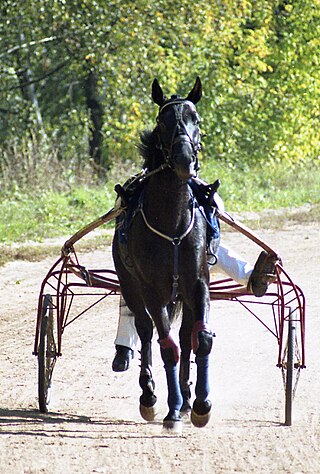
The Russian Trotter is a breed of trotting horse from the Russian Federation. It originated from cross-breeding of native Orlov Trotter horses with imported American Standardbred stock from about 1890; by about 1950 the Russian Trotter breed was considered established, although some cross-breeding with American stallions continued. A stud-book was established in 1927; in 1989 it ran to 23 volumes.
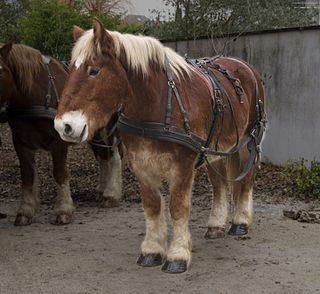
The Trait Breton is a French breed of draught horse. It originated in Brittany, in north-west France, from cross-breeding of local horses with various other breeds. It is strong and muscular, and often has a chestnut coat.

The Landais is a critically-endangered French breed of small horse or pony. It originated in the marshy plains and woodlands of the département of the Landes, in the Nouvelle-Aquitaine region of south-western France, but is more often reared in the département of Pyrénées-Atlantiques, particularly in the arrondissement of Pau. Due to influences from Arab and Welsh blood, it shows more similarity to Oriental horses than to other Celtic breeds. It is used for riding and driving, and is a good trotter.

The Gelderlander is a Dutch breed of warmblood horse. It was bred in the province of Gelderland in the Netherlands as a carriage horse capable also of farm work. It declined in popularity in the mid-twentieth century. In 1965 it was one of the foundation breeds of the Dutch Warmblood or KWPN, the other being the heavier Groninger horse from the north. It is registered in a division of the Royal Dutch Warmblood Horse Studbook, which also has divisions for the Dutch Warmblood and for the Dutch Harness Horse.
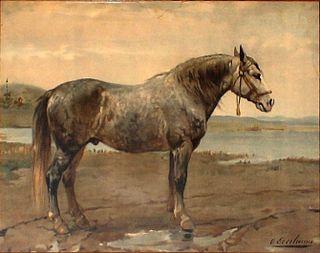
The Russian Draft or Russian Heavy Draft is a Russian breed of draft horse. It was bred in Imperial Russia in the second half of the nineteenth century, and until after the Russian Revolution was known as the Russian Ardennes. It is one of a number of draft breeds developed there at approximately the same time, others being the Lithuanian Heavy Draft, the Soviet Heavy Draft and the Vladimir Heavy Draft; it is both the oldest and the smallest of them. The present name dates from the Soviet era, and was used from 1952.

The North Swedish Horse is a Swedish breed of small heavy horse. It is closely related to the similar Dølehest breed of Norway. It was traditionally used for forestry and agricultural work. Lighter lines are bred for harness racing, and are registered in the stud-book of the Svensk Kallblodstravare.

The Barbu d'Uccle or Belgian d'Uccle, Dutch: Ukkelse Baardkriel, is a Belgian breed of bearded bantam chicken. It was first bred in the town of Uccle on the outskirts of Brussels, in central Belgium, in the early years of the twentieth century. It is a true bantam, with no standard-sized large fowl counterpart, and is one of eleven Belgian true bantam breeds.
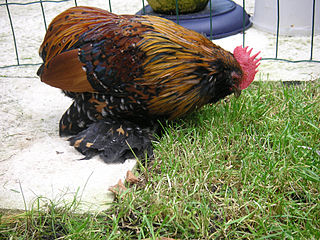
The Barbu d'Everberg, is a Belgian breed of bantam chicken. It is a tailless variant of the Barbu d'Uccle, and was bred in about 1906 at the Château d'Everberg, at Everberg in the municipality of Kortenberg, between Brussels and Leuven. It is among the most endangered chicken breeds in Belgium, and in 2010 its conservation status was classed as "critical". It is a true bantam, with no large counterpart. Cocks weigh 700–800 grams, and hens 550–650 g.

The French Trotter is a French breed of trotting horse bred for racing both ridden and in harness. It was bred specifically for racing in the nineteenth century, principally in Normandy in north-western France.
The Vlaamperd is a South African breed of light draught or harness horse; it is also suitable for riding. It was bred in the Western Cape region of South Africa in the early twentieth century, and resulted from cross-breeding of local mares with imported European stallions, particularly Friesians. The horses are usually black, though mares may be dark seal brown. A stud-book was started in 1983.
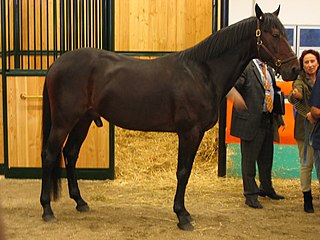
The Italian Trotter, Italian: Trottatore Italiano, is the Italian breed of trotting horse. It has been selectively bred exclusively for its racing ability. Varenne, one of the most successful trotters in the history of the sport, was an Italian Trotter.
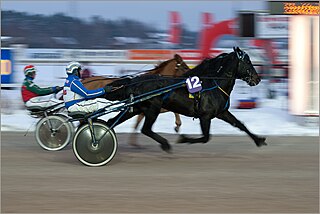
The Scandinavian Coldblood Trotter consists of two closely related and interconnected breeds of trotting horse: the Norsk Kaldblodstraver or Norwegian Coldblood Trotter and the Svensk Kallblodstravare, the Swedish Coldblood Trotter or North Swedish Trotter. Coldblood trotters are the result of cross-breeding native coldblooded farm horses – in Norway the Dølehest, in Sweden the North Swedish Horse – with lighter and faster horses. Although the Norwegian and Swedish coldblood trotters are substantially considered a single breed, two national stud-books are maintained, and registration requirements differ in some respects between the two countries.
The Belgian Bantam, Dutch: Belgisch kriel, French: Naine belge, is a breed of bantam chicken from Belgium. It is a true bantam, and has no full-sized counterpart; cocks weigh about 650 grams and hens about 550 g. It is in danger of extinction; in 2010 a total of 168 birds were counted in the whole of Belgium. Fourteen colour patterns are recognised in the European standard.

The Ardennaise, French: Poule ardennaise, is a breed of domestic chicken from the Ardennes plateau, in Belgium and eastern France. Its range extends from the Pays de Herve in Wallonia to the French département of Ardennes, and includes the Fagnes, the Famenne, and the valleys of the Amblève, the Ourthe and the Semois.
The Bassette Liégeoise or Bassette is a breed of large bantam chicken from Belgium. It is larger than most bantams, but much smaller than full-sized breeds; cocks weigh about 1000 grams and hens about 900 g. Like most Belgian bantam breeds, it is in danger of extinction. Eighteen colour patterns are officially recognised; many of them are rare.

The Belgian Sport Horse, Dutch: Belgisch Sportpaard, French: Cheval de Sport Belge, is a Belgian breed of warmblood sport horse. It is one of three Belgian warmblood breeds or stud-books, the others being the Belgian Warmblood and the Zangersheide. It is bred for dressage, for show-jumping and for three-day eventing.

The Zangersheide is a Belgian breed or stud-book of warmblood sport horses. It is one of three Belgian warmblood breeds or stud-books, the others being the Belgian Sport Horse and the Belgian Warmblood. It is bred at the stud of the same name near Lanaken, in the province of Limburg in eastern Flanders, close to the Dutch border. Breeding and selection are directed at performance in show-jumping.
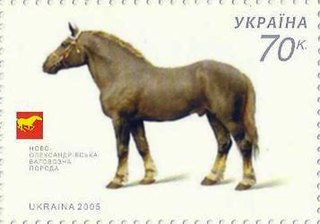
The Novoolexandrian Draught is a Ukrainian breed of draught horse. It is named for the state stud farm of Novo-Oleksandrivka in Bilovodsk Raion of Luhansk Oblast in the easternmost part of Ukraine, where it was bred. It shares its early history with the Russian Heavy Draught bred in Imperial Russia in the second half of the nineteenth century, and until after the Russian Revolution known as the Russian Ardennes; later development took place in Ukraine, where it received official recognition in 1999. It was bred for draught work, but it is also reared for meat and particularly for mare's milk, of which it is a high-yielding producer.
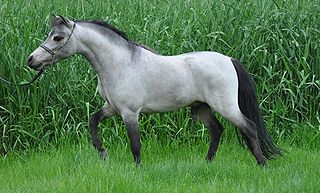
The American Miniature Horse is an American breed of small or miniature horse. It has been selectively bred to display in miniature the physical characteristics of a full-sized horse, and usually stands no taller than about 38 in (97 cm). It frequently has the appearance of either a small Arab or a small draft horse; genetically it is no different to pony breeds such as the Shetland.
References
- ↑ Barbara Rischkowsky, D. Pilling (eds.) (2007). List of breeds documented in the Global Databank for Animal Genetic Resources, annex to The State of the World's Animal Genetic Resources for Food and Agriculture. Rome: Food and Agriculture Organization of the United Nations. ISBN 9789251057629. Accessed January 2017.
- ↑ Paul De Brauwer (2004). Het Belgisch trekpaard: een levend monument (in Dutch). Warnsveld: Lannoo. ISBN 9789020958294.
- ↑ Valerie Porter, Lawrence Alderson, Stephen J.G. Hall, D. Phillip Sponenberg (2016). Mason's World Encyclopedia of Livestock Breeds and Breeding (sixth edition). Wallingford: CABI. ISBN 9781780647944.
- ↑ Élise Rousseau, Yann Le Bris, Teresa Lavender Fagan (2017). Horses of the World. Princeton: Princeton University Press. ISBN 9780691167206.
- ↑ Avis Officiel – Officiele Berichten: Fevrier – Februari 2009 (in French and Dutch). Jockey-Club de Belgique – Belgische Jockey Club. Accessed June 2019.
- ↑ Breed data sheet: Trotteur Belge / Belgium (Horse). Domestic Animal Diversity Information System of the Food and Agriculture Organization of the United Nations. Accessed April 2019.